A bright and colorful flower bed is undoubtedly proud of any owner of a private house or an avid gardener. Everyone tries to find a plant or flower, which would bear their paints to the coldests.
In such colors can be attributed to gas or gasania. This flower, like a bright sun, decorates the plot until the first frost is on. Due to its diversity in the colors of inflorescences, the height of the stem, the root system, gas can be grown in any areas of Russia and the CIS countries. In any case, even under the harsh conditions, the flower of gas is perfectly in balconies, greenhouses, balconies in flower pots.
In this article, we will consider the features and description of Gazania, we describe the most basic types and varieties of this plant. We will tell you more about the peculiarities of growing gas in the open soil and at home.
Features and Description of Gazania
Gazania is a perennial representative of the Astrov family or complex family. Many gardeners have the question of which to choose gas is one-year or multi-year. This flower is extremely perennial, simply in the conditions of our harsh climate it is possible to grown to gas as an annual. If you wish for winter, you can transplant the plant in the flower pot and put on the windowsill. And with the arrival of the spring, return the flower of gas to the previous place. The natural habitat of this bright plant is the territory of Mozambique and South Africa, as well as the warm coast of Australia.
In Europe, Gazania appeared at the end of the 17th century and very quickly received recognition and love in many countries. The current name of the flower was in honor of the Italian priest of Theodore, the background of Gaza, who at one time translated the famous works of Aristotle and the Phrast. Gazania has a number of other names that gave a plant in different countries based on its external characteristics. For example, in Western European countries, Gazania is called "Flower of the Sun". The explanation for this name is simple - the gas dissipates its inflorescences only at noon, and at night and in cloudy weather, the flowers do not bloom at all.
Sometimes in the literature you can meet another name of Gazania - "African Chamomile", which the plant received for a bright color of petals and a natural habitat.
Description of Gazania:
- Gazania is a herbaceous plant, which can sometimes grow in the form of low-spirited half-workers, forming a root rosette from the stem and leaves.
- In nature, many years of gazania are more common, but annual representatives of the genus are known.
- Gazania is a low-spirited plant, which in height reaches only 20-30 cm.
- Different types of gazania may have a short stem, and others do not have it at all.
- The leaves create a beautiful and thick root rosette, due to which this plant looks great as an ornament of garden tracks and borders.
- The leaves are dark green or light green, on the bottom side are most often covered with light villings that protect the flower from the cold and help to hold moisture.
- In the form of leaves may be different, it all depends on the specific type and variety of gas.
- The main decoration of the plant is his inflorescences. Outwardly, they resemble the usual chamomile, only in the gazanium flower is larger and has a bright color.
- Flowers are represented by single inflorescences - baskets that reach 5-9 cm in diameter.
- The inflorescence of Gazania consists of tubular petals located in the middle and having a golden color, as well as from the tongue petals painted in red, orange, yellow, pinkish shades with a brown spot in the center of each petal.
- On one plant, about 30-35 inflorescences can be at the same time.
- After the flows of flowers on the plant, fruits appear - hairy seeds.
- Gazania can be grown in open ground and at home.
Species variety of gas: bright paints of popular varieties
To date, there are about 40 types of gas, which have different peculiarities of growing, colors and a form of leaves. On the territory of Russia, where a more severe climate is possible to grow only annual gas. If there are beautiful perennial species on your site, you can easily transplant them into pots and put into a room with a comfortable temperature. Consider the most popular types and varieties of gas, which can be grown in open soil and at home in Russia and the CIS countries.
Hybrid Gazania
- This type of gas is treated with varieties obtained by crossing species representatives.
- Hybrid gas can be grown as an annual plant.
- In height, the plant can reach about 25-30 cm.
- Stem in the plant, the root rosette is formed below, from which the leaves grow.
- Leaves in hybrid gazanium varieties palchatic-disseated or linear. The color can be dark green or light green, the lower plate of which is painted in silver-gray.
- Inflorescences are represented by single baskets of different colors. To date, there are simple and terry flowers, red, yellow, orange, pink, burgundy and other shades.
- Gazania hybrid varieties do not produce seeds almost, so their reproduction is possible only by means of cuttings.
- Flowering begins in late June and lasts up to the frost.
Popular varieties:
- Gazania "Russian size» F1. The most popular grade of today. Bright gold or orange blossoms are mounted on strong peduncles. Diameter inflorescence up to 12 cm, which classifies grade to the largest.
- Gazania "Kiss flame." It features a large number of inflorescences, blooming at the same time.
- Gazania "Shansonnet". Plant with colorful buds.
brilliant gazania
- This type of gazania has another name - gazania harsh.
- It is a perennial, but in a climate of central Russia and other CIS countries, is grown as an annual gazania.
- The plant reaches 20-25 cm in height due to the high stems.
- The leaves of this species gazania dark green color, are pinnate or lancet shape. Mounted without roots and reach a length of 10-12 cm.
- Inflorescences are solitary baskets, which are mounted on a strong and long flower stalks that grow from the center of the rosette.
- Inflorescences average diameter reaches 6-8 cm.
- Flowers coloring can be monochrome or two-color with stripes and spots. Central tubular petals may also have a different color from golden-yellow to brown.
- During the whole period of flowering on the same plant can be dissolved in an average of 60 inflorescences.
gazania dlinnostrelkovaya
- It is an annual herbaceous plant that reaches a height of 15-20 cm.
- Unlike many other forms of gazania, dlinnostrelkovaya has a stem that creeps upon the earth.
- Leaves bright dark green or pale green color, whose bottom plate has a small pubescence.
- The shape of the leaves in this species gazania entire or slightly cut.
- Inflorescence single baskets are presented, which can reach a diameter of 7 cm.
- Reed petals inflorescences are bright golden-yellow color with a small brown spot at the base, and the central tubular - yellow.
- Flowering period gazania dlinnostrelkovoy of several months, beginning in early August and lasts until the first frost.
gazania Potts
- Also a herbaceous perennial plant of the family Slozhnotsvetkovye.
- This species is morphologically similar to the brilliant gazania.
- The height can be up to 25-30 cm.
- It has a rather large inflorescences, which can have a diameter of about 12 cm.
gazania peacock
- This type of gas is a perennial semi-staple, which, due to our harsh climate, is grown as an annual plant.
- The surface of the earth is a short stem.
- Leaves are oblong, all-string or slightly cut. Length can reach 20 cm.
- The color can be bright green from the upper side and with a small silver feed on the bottom plate.
- Inflorescences are represented by single baskets, which in diameter reach 8-9 cm.
- The central petals have a yellow shade, and the tongue is bright orange with a brown spot at the base.
The above-mentioned types and varieties of gas were obtained the greatest distribution in Russia and other CIS countries.
Gazanian reproduction: the most common ways
It will not be much difficult to grow gazania. After all, it is not for nothing that this flower is easily given by novice gardeners. For the reproduction of this plant, two ways are suitable: seed reproduction and shilling. It must be remembered that the reproduction of stinginess is suitable only with hybrid gazanium varieties. Having understood in the presented ways of independent gazania, you can choose the most suitable for yourself.
Seed reproduction of Gazania
- This type of reproduction is used most often. However, it is necessary to remember that when using it for hybrid varieties, you risk not seeing bright and colorful inflorescences that were previously represented.
- Seeds for breeding can be purchased in specialized stores, and can be assembled independently in the presence of gas on your site. To do this, wait until the boutons are full of bunning, gently cut it and place it in a dry place where the seeds quickly freeze. Gazania from seeds collected at the same time can be grown for 2 years, as it is this period that is characteristic of the normal germination of seeds.
- Seeds of gas can be soiled directly into open ground or can be cultivated by seedlings.
- For sowing seeds of Gazania, the first days of the spring are suitable for seedlings or the end of February. However, note that with an earlier crop, the plant may not be enough light. In this case, it is necessary to create artificial lighting.
- It is not necessary to germinate the seeds, it is enough to moisten the soil.
- In early March, prepare enough spacious and deep boxes so that the rod root system of the gas is not bent, and grew straight and without damage.
- Next, it is necessary to fill the boxes of light and nutrient soil, which should consist of sand, peat, delicate earth and humus.
- On the surface of the soil gently spread the seeds of the gas. This can be done in a checker order, while observing the distance between them in 2-2.5 cm.
- From above you can sprinkle seeds with a thin layer of pure sand, after which it is moistened to moisten everything from the spray gun.
- Next, boxes with seeds need to be covered with a film or glass and put into a warm room with a temperature of 18-20 degrees.
- Be sure to regret the seeds daily and delete condensate.
- Peat pots can be used as a container for seed shoots.
- Usually shoots appear after 1-2 weeks after sowing.
Seedling Gazania
- If you sowed the seeds of gazania in peat pots, you do not need to dive.
- Placed seeds in a common container need thinning.
- When three strong leaves appear on seedlings, it is necessary to dive them into separate containers. In this case, you can also use peat pots.
- Next, seedlings need to be hardened. To do this, the seedlings are placed on the premises with a cooler temperature - about 12-16 degrees. You can use a balcony or loggia, naturally they must be insulated.
- The elements of the natural hardening of the seedlings of the Gazania are daily air ventilation. For this, you can open the window for a while.
- In the open soil, gas is planted only in May or June.
Grinding gazania gripping
- This method of reproduction is suitable only for hybrid gzania varieties, which during breeding with the help of seeds loses its maternal signs.
- It is necessary to engage in the preparation of cuttings in the summer.
- On a healthy adult bushing of Gazan, you need to choose strong and long side shoots.
- Use a sharp knife for cutting cuttings. At the same time, make sure that each cut cutter has a heel, just that they can take care.
- After that, each cutlets are free from the lower leaves and process the location location with a stimulant of the root formation, for example, rhoin. To do this, prepare this solution and place all cuttings in it. Enough to leave them for the night.
- To root the cuttings in the prepared containers or directly into the greenhouses. The soil must consist of peat, sand and turf with an admixture of humus.
- During the rooting, it is necessary to regularly water the cuttings and ventilate them.
- The rooting process on average takes 1.5-2 months.
- In the open ground, planting gazania from cuttings is carried out in May.
- First days after landing, be sure to provide seedlings to cover from direct sunlight.
Stages of preparation before landing
To get a strong and beautiful plant, it is important to carefully prepare before landing. It is necessary to carefully pick up plant seedlings, focusing on your climatic conditions, as well as pick up on your site the most suitable place for landing. It is important to prepare the soil for gas. Consider all stages of preparation details.
Stage 1. Selection of varieties and gazania seedlings
- First of all, decide on, you will land the gas in the open soil or in the room pot. It is also possible to acquire many years of gas, put it in an open ground, and then for the winter to transplant into a pot and contain indoors.
- Separate gazanium varieties are needed very carefully. Focus on plants that are adapted to the climatic conditions of your area.
- If you decide to buy gas seedlings, then do it best in specialized stores or agrofirms, which are professionally engaged in breeding various plants.
- Before buying, check with the seller all the nuances of growing plants, which lighting it is necessary and feeding.
- Carefully inspect the plant itself. It should not be visible damage, signs of disease and pests.
- If you buy seeds for breeding seedlings, give preference to less exotic varieties. Remember, the birthplace of Gazania is Mozambique. And in the conditions of our climate, more rare and exotic varieties can simply not survive.
Stage 2. Selecting a place for landing for gas
- Gazania can immediately put the seedlings in the pots and put on a glazed balcony or loggia. In this case, every summer of the pots need to be simply taken out to the street, and with the onset of cold weather, bring to the house.
- Reverse situation is possible. To plant the seedlings of Gazania in the open soil, and to dig up and put in the room flower pots.
- In any case, Gazania requires solar and well-lit plots. After all, the flowers of gazania dissolve only in the presence of sunlight.
- At the selected place should also be lack of drafts and strong gusts of the wind.
- Gazania does not like dampness and stagnation of water, so avoid lowlands and swampy sites.
- Gas's flowers are perfectly suitable for flower beds and flower beds. as well as for mixtures and alpine slides.
Stage 3. Soil preparation before landing.
- Gasia does not endure heavy clay soils.
- It can feel great on sandy or squealed soils. However, the soil mixture is optimal for its growth is the following: sand, peat, nervous land, leafy land and humus.
- The selected landing place should be well drained and detain moisture from the roots.
- The soil hydrogen indicator on the site must be within 5.5-6.5 pH.
- Before the landing itself, the selected area must be thoroughly swing, approximately one bayonet shovel. Remove all the weeds of the Derne, you can add a little fruit as a fertilizer.
Gasania landing technology
You can plant gas seedlings in both open soil and flower pots.
Gas landing in a pot
- If you decide to raise gas at home, first of all, pick up a deep and fairly free pot or container. The outdoor flower pot is perfect, in which gas will feel perfectly.
- The selected pot fill in light and nutrient soil, which should include sand, peat, nervous land.
- Do not forget to make a pot or container to place small stones, gravel or broken brick. It will provide good drainage.
- Pour the soil with water and put in the pot of Gazania seedling.
- During wintering gazania, do not overdo it with watering.
- It is important to put a pot with Gazania in a sunny place. A balcony or window is perfect.
Gazan landing in open ground
- On the prepared area, carefully explode the soil and make the landing pits suitable for seedlings.
- Consider that the seedlings of Gazania need to plant in open ground with an earthen room, so the wells must be twice as much.
- Place a small layer of drainage on the bottom of each landing well. As a drainage, use gravel, pebbles, broken brick or clay. It is necessary to prevent stagnation of water from the roots.
- If you are crushed seedlings in peat pots, span and water and gently place immediately into the landing well. When growing seedlings in containers, also spawn the surface of the soil and gently remove the seedlings with a long shovel or Sovkom separately. It is important not to damage the rod root of the plant.
- It is also important to adhere to the distance between the plants. It should be at least 20 cm.
- The soil around the plants can be sprinkled with mulch to reduce the number of weeds and prevent the soil drying.
Gasania care features
Further growth and flowering of gas will depend on your attention and care. Gasia is not a demanding flower and feels great with minimal departure, but some efforts are still needed.
Watering Gazania
Gazania is sufficiently drought-resistant plants and can work without water for a long time without water. This flower categorically does not tolerate the convergence and stagnation of water from the roots. Watering is needed moderate. The optimal mode is rarely watering, but abundantly. This is especially concerned about the dry time of the year.
Loosening and mulching
Once every 2-3 weeks after watering it is important to thoroughly loosen the soil around the plants. To do this, you can use special garden tools, and you can make hands. The root system in the gazanium rod, so you can't damage it. In parallel, remove all weeds and climb the rolling circle with sawdust or dry peat.
Podchar
Gazania also needs periodic feeding to maintain growth and for the formation of new infloretia buds. Approximately once a month it is necessary to help your gazania with a complete complex mineral fertilizer per 20-25 grams per square meter. You can feed together with watering.
Gasia after flowering
During the flowering of gas, it is important to periodically delete all the faded buds. Thus, you encourage the growth of new ones, which will allow your Gazania to please the surrounding colors to the most frosts. In the fall, you need to decide whether you will save the plant for the next year or, like all annuals, remove it from the bed. If you all decided to pick up the gas to the room, carefully dig it with a lore of the earth and transope in a large and deep pot. Place it into the cool room with a temperature of 12-14 degrees.
Fighting diseases and pests
Gazania is very simple to leaving the plant. This flower is very rarely affected by various diseases and pests. It happens most often due to improper care.
Diseases:
- Gray rot. Small spots on the leaves and plants stems are caused by a gray rot, which is detrimental for plants. When detecting urgently remove all damaged areas and treat the rest of the plant with fungicides. If damage is serious, remove all the plant and treat the soil.
Pests:
- Caterpillars These pests can be collected manually. The same applies to the slug, which can sometimes harm the gas.
- Aphid. This pest can destroy the leaves of gazania and flowers. To combat it, special insecticides can be used, for example, phytodeterm.
- Cute tick. To combat this pest, you can use Aktellik or Fuffanon.
Stock Foto Gasia in landscape design
If you want to decorate your garden or plot and make it bright to the most frosts, be sure to plant a gas station that will not require much costs and efforts. And gives a huge amount of paints and joy.

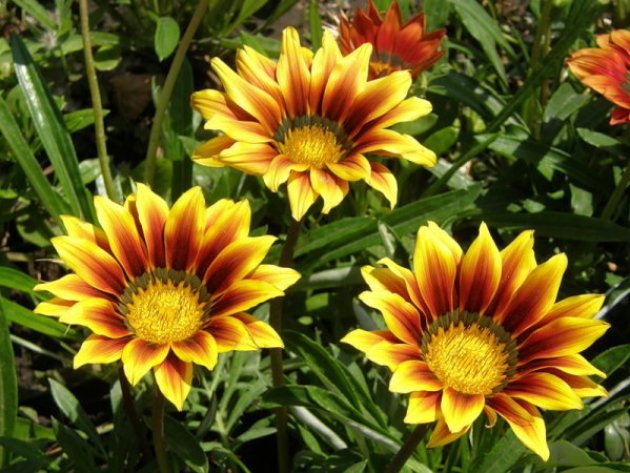
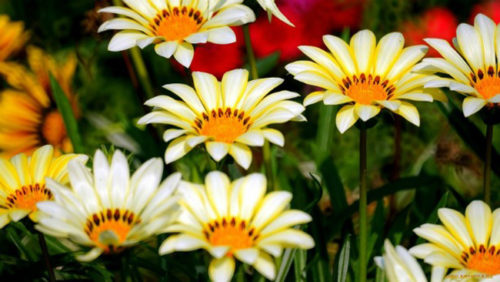
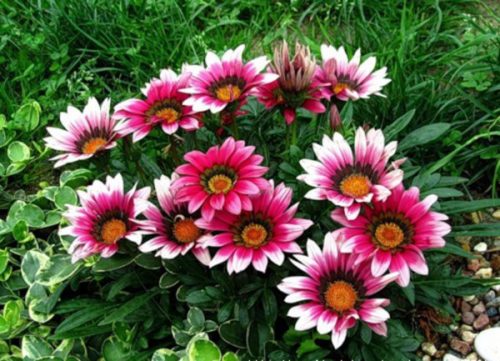

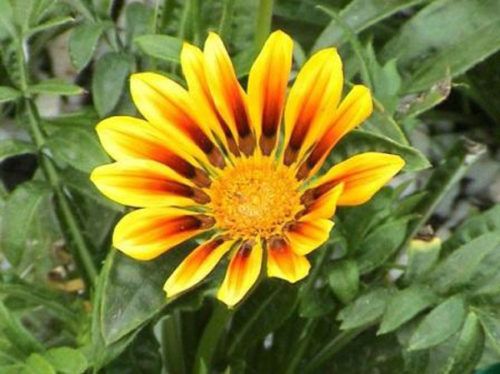
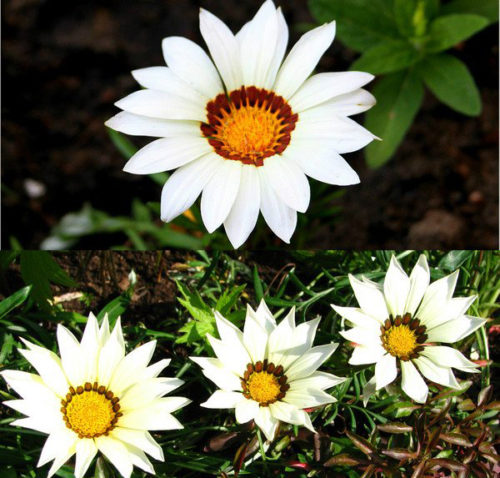
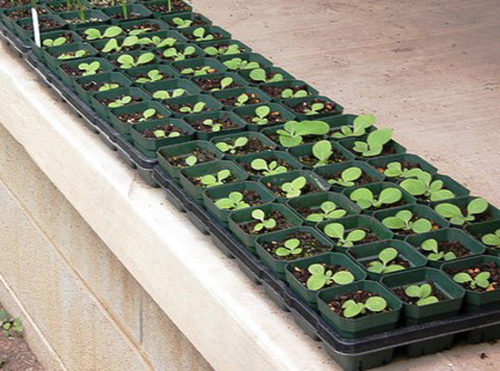

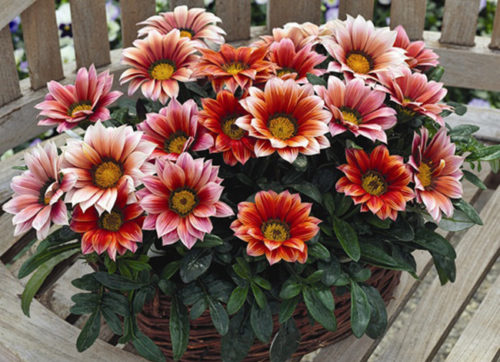
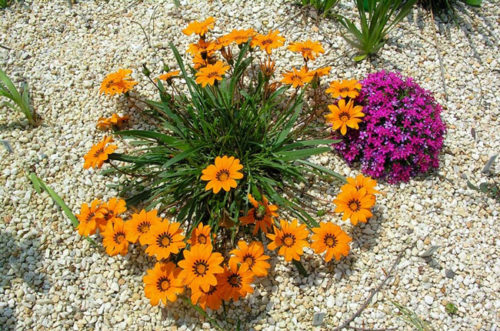
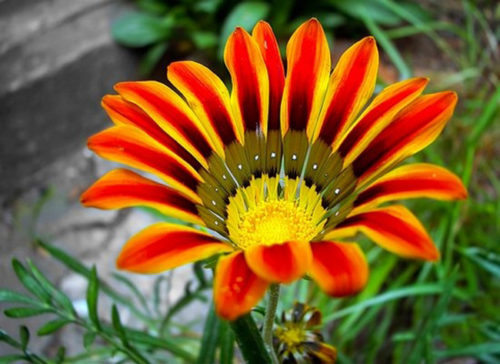
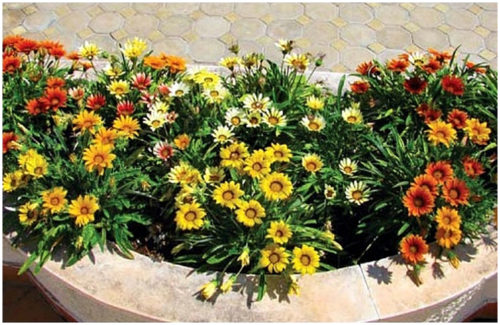
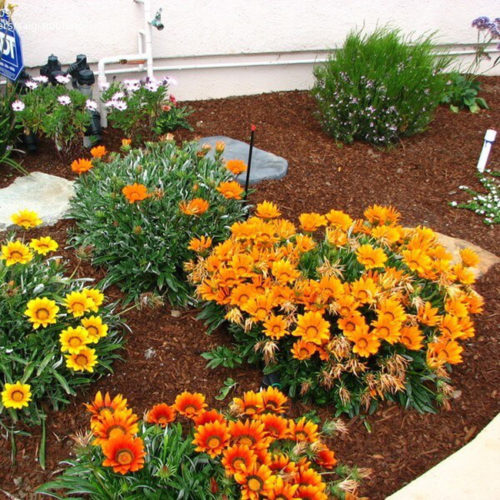













 Start a discussion ...
Start a discussion ...